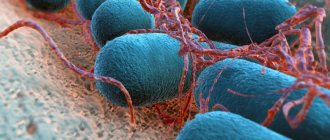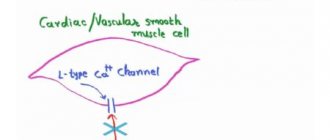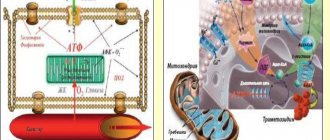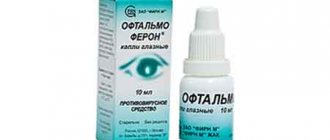The drug Spiramycin® belongs to the class of macrolide antibiotics, being the first representative of their 16-membered structural modification.
The specific structure of the drug determines its long-term antibacterial effect, as well as the ability to accumulate in the highest possible concentrations in the inflammatory focus.
When low doses of the drug are prescribed, it acts bacteriostatically (suppresses the growth and reproduction of pathogens), and when high dosages are prescribed, it acts bactericidal (destroys pathogenic microorganisms).
The drug has a wide spectrum of antimicrobial action and is used for antibiotic therapy of bacterial infections of various locations (infections of the skin, respiratory system, genitourinary tract, and others).
Pharmacodynamics and pharmacokinetics
Pharmacodynamics
Spiramycin is a macrolide antibiotic . It has a bacteriostatic effect, and a bactericidal effect in high doses. By reversibly binding to the 50S ribosomal subunit of the microorganism, it suppresses protein synthesis in the cell. The longer lasting antibacterial effect, unlike other macrolides, is due to the fact that it binds to three subunit domains. It accumulates in high concentrations in the bacterial cell.
The following are sensitive to the drug: Staphylococcusspp., Neisseriameningitidis, Listeriamonocytogenes, Neisseriagonorrhoeae, Corynebacteriumdiphtheriae, Streptococcusspp., Bordetellapertussis, Mycoplasmapneumoniae, Legionellapneumophila, Chlamydiaspp., Clostridiumspp., Treponemaspp., Leptospiraspp., Toxoplasmagondii , Campylobacter spp.
Resistant: Pseudomonas spp., Streptococcus pneumonia, Enterobacteriaceae spp.
Pharmacokinetics
Absorption from the gastrointestinal tract does not occur completely. After taking 2 tablets, Cmax is 3.3 mcg/ml. It has low (10%) binding to plasma proteins. Penetrates well into saliva, lungs, tonsils, paranasal sinuses, and bones. Does not penetrate the BBB. Penetrates through the placental barrier - in the fetal blood the concentration of the drug is 50% of the concentration in the mother's blood. Metabolized in the liver, its metabolites are active. It is excreted mainly in bile and slightly in urine. T1/2 is about 8 hours after taking 1 tablet orally.
Pharmacological properties of the drug Spiramycin
Antibiotic of the macrolide group. The following microorganisms are sensitive to spiramycin: Streptococcus spp. , including Streptococcus pneumoniae, Bordetella pertussis, Corynebacterium diphtheriae, Chlamydia trachomatis, Legionella pneumophila, Listeria monocytogenes, Clostridium spp., Mycoplasma pneumoniae, Neisseria gonorrhoeae, Treponema spp., Leptospira, Campylobacter spp. and Toxoplasma gondii . Moderately sensitive: Haemophilus influenzae, Bacteroides fragilis, V. cholerae, Staphylococcus aureus. Enterobacteriaceae, Pseudomonas are resistant to spiramycin Rapidly absorbed after oral administration (half-absorption period is 20 minutes). After ingestion of 6,000,000 units of spiramycin, its maximum concentration in the blood plasma is achieved after 1.5–3 hours; half-life is about 8 hours. Spiramycin does not penetrate into the CSF; diffuses well into saliva and tissue, as well as into breast milk, and therefore its use in women during breastfeeding is not recommended. Binding to blood plasma proteins is weak and does not exceed 10%. Metabolized in the liver and excreted in bile, feces and urine (10–14%). The concentration in the lungs is 20–60 mcg/g, in the tonsils - 20–80 mcg/g, in the sinuses during inflammation - 75–110 mcg/g, in bone tissue - 5–100 mcg/g, in the spleen, liver, kidneys - 5–7 mcg/g.
Indications for use
- toxoplasmosis (including during pregnancy);
- community-acquired pneumonia (chlamydial, mycoplasma and caused by aerobic gram-negative bacteria);
- exacerbation of chronic bronchitis ;
- rheumatism, unspecified;
- acute bronchitis ;
- acute tonsillitis , sinusitis , otitis ;
- osteomyelitis;
- sexually transmitted diseases;
- urethritis;
- skin infections;
- prevention of meningitis caused by meningococcus (in persons who had contact with patients);
- bacteria carriage of whooping cough and diphtheria .
Spiramycin
International name of the medicinal substance:
Spiramycin The list of drugs containing the active substance Spiramycin is given after the description.
Pharmacological action:
Natural antibiotic from the macrolide group, acts bacteriostatically (when used in high doses it can act bactericidal against more sensitive strains): suppresses protein synthesis in the microbial cell due to reversible binding to the 50S ribosomal subunit, which leads to blockade of transpeptidation and translocation reactions .
Unlike 14-membered macrolides, it is able to bind not to one, but to three (I-III) domains of the subunit, which possibly provides more stable binding to the ribosome and, therefore, a longer antibacterial effect. Can accumulate in high concentrations in the bacterial cell. Unlike erythromycin, it does not stimulate gastrointestinal motility. The following microorganisms are sensitive to the drug: Staphylococcus spp. (including strains of Staphylococcus aureus sensitive to methicillin), Streptococcus spp., Neisseria meningitidis, Neisseria gonorrhoeae, Bordetella pertussis, Corynebacterium diphtheriae, Listeria monocytogenes, Clostridium spp., Mycoplasma pneumoniae, Chlamydia spp., Legionella pneumophila, Treponema spp. ., Leptospira spp., Campylobacter spp., Toxoplasma gondii. Moderately sensitive: Haemophilus influenzae. Resistant to spiramycin: Enterobacteriaceae spp., Streptococcus pneumoniae, Pseudomonas spp. There is cross-resistance between spiramycin and erythromycin. Pharmacokinetics:
Absorption is incomplete, bioavailability when taken orally is 33-39% (from 10 to 69%). The rate of absorption is lower than that of erythromycin, which is obviously due to the high pKa value (7.9) of spiramycin, which suggests a high degree of ionization in the acidic contents of the stomach. Taking with food reduces bioavailability by 50% and increases TCmax. TCmax after oral administration - 3-4 hours, with intravenous administration - by the end of the infusion; Cmax when taken orally at a dose of 1 g is 1 mcg/ml, at a dose of 2 g - 1.6-3.1 mcg/ml, when administered intravenously at 500 mg - 2.3 mcg/ml. Bonding with plasma proteins is 10-25%. Does not penetrate into the CSF, penetrates well into tissues and body fluids (including breast milk). Concentration in the lungs - 20-60 mcg/g, in the tonsils - 20-80 mcg/g, in the sinuses during inflammation - 75-110 mcg/g, in bone tissue - 5-100 mcg/g, in the spleen, liver, kidneys - 5-7 mcg/g. Penetrates the placental barrier (the concentration in the fetal blood is 50% of the concentration in the maternal blood serum). Concentrations in placental tissue are 5 times higher than corresponding concentrations in serum. High concentrations are achieved in bile (15-40 times higher than in blood serum), polymorphonuclear leukocytes. The volume of distribution is large and variable - 383-660 l. Metabolized very slowly in the liver, excreted in the bile (more than 80% of the dose) and kidneys (4-14%); enterohepatic recirculation is possible. T1/2 with intravenous administration: young people (18-32 years) - 4.5-6.2 hours, elderly (73-85 years) - 9.8-13.5 hours; when taken orally - 5.5-8 hours.
Indications:
Toxoplasmosis during pregnancy.
Bacterial infections caused by sensitive microorganisms: acute community-acquired pneumonia (including atypical pneumonia caused by Mycoplasma, Chlamydia, Legionella), exacerbation of chronic bronchitis, acute bronchitis; sinusitis, tonsillitis, otitis media; osteomyelitis, arthritis; extragenital chlamydia, prostatitis, urethritis of various etiologies; sexually transmitted diseases (including genital chlamydia, syphilis, gonorrhea and their combination). Skin infections: erysipelas, infected dermatoses, abscess, phlegmon (including in dentistry). Toxoplasmosis; prevention of meningococcal meningitis among persons who were in contact with patients no more than 10 days before hospitalization. Prevention of acute articular rheumatism. Treatment of bacterial carriage of whooping cough and diphtheria pathogens. Contraindications:
Hypersensitivity, childhood (for IV infusions), lactation period.
Side effects:
Nausea, vomiting, diarrhea, allergic reactions (skin rash, itching), pain at the IV injection site;
rarely - increased activity of ALT and alkaline phosphatase. In isolated cases - thrombocytopenia, prolongation of the QT interval on the ECG, cholestatic hepatitis, acute colitis, ulcerative esophagitis, damage to the intestinal mucosa. Interaction:
Prescribe with caution with drugs containing dehydrated ergot alkaloids.
The combination of levodopa and carbidopa increases T1/2 of levodopa, which may be due to the suppression of carbidopa absorption by spiramycin due to changes in gastrointestinal motility. Unlike erythromycin (a related macrolide), spiramycin is not metabolized by liver P450 isoenzymes and does not interact with cyclosporine or theophylline. Special instructions:
Even in the presence of severe renal dysfunction, there is no need to adjust the dosage regimen.
When prescribed to nursing women, it is necessary to stop feeding, as it may pass into breast milk. Spiramycin has not been found to have a teratogenic effect, so it can be used without fear in pregnant women. A decrease in the risk of transmitting toxoplasmosis to the fetus during pregnancy is noted from 25 to 8% when used in the first trimester, from 54 to 19% in the second and from 65 to 44% in the third trimester. In patients with liver disease, liver function should be periodically monitored during treatment. It is not recommended to use tablets in a dose of 3 million units in pediatric practice. Preparations containing the active ingredient Spiramycin:
Rovamycin, Spiramisar, Spiramycin-vero
The information provided in this section is intended for medical and pharmaceutical professionals and should not be used for self-medication. The information is provided for informational purposes only and cannot be considered official.
Side effects
- pseudomembranous colitis , nausea , vomiting , ulcerative esophagitis , cholestatic hepatitis ;
- transient paresthesia ;
- thrombocytopenia , acute hemolysis ;
- prolongation of the QT interval;
- Quincke's edema , rash, itching, rarely - anaphylactic shock .
Popular drugs
In the list of macrolide antibiotics, there are two substances that are most commonly used at the moment:
- clarithromycin;
- azithromycin.
These are representatives of two different generations of macrolide drugs. From these, azithromycin was later obtained. Despite the fact that they are united by the mechanism of action on microbes and belonging to the same group, there are significant differences:
| Comparison parameter | Azithromycin | Clarithromycin |
| Microbial spectrum of action |
| |
|
| |
| Effect speed | Within 2-3 hours. A stable concentration of the drug in the blood appears after 5-7 days of regular use. | Within 2-3 hours. A stable concentration of the drug in the blood occurs after 2-3 days of regular use. |
| Efficiency | Equally effective in the treatment of Helicobacter gastritis. Azithromycin distributes better throughout the lung tissue when treating a pulmonary infection, however, the effectiveness of the drug is similar to clarithromycin in a similar case of administration. Azithromycin is more effective against legionellosis. | |
| Adverse reactions |
| |
|
| |
| Safety for pregnant and lactating patients |
| |
Thus, the advantages of azithromycin include fewer adverse reactions in the form of severe life-threatening conditions.
For clarithromycin, the advantages of use are a wider spectrum of action and rapid achievement of stable levels in the patient’s blood.
The main disadvantage for both macrolide antibiotics is their undesirable use in pregnant women, which complicates the choice of drug in this population group.
Instructions for use Spiramycin-Vero (Method and dosage)
Taken orally. Adults—2-3 tablets. 3 million IU per day, divided into 2-3 doses. The maximum daily dose is 9 million ME.
To prevent meningitis caused by meningococcus, take 1 tablet (3 million ME) per day for 5 days.
IV drip only for adults: the contents of the bottle are dissolved in 4 ml of water for injection + 100 ml of 5% dextrose solution .
For pneumonia , 1.5 million IU is prescribed every 8 hours.
Instructions for use of Spiramycin-Vero contain information that if renal function is impaired, dose adjustment is not carried out.
Spiramycin® analogues
The drug most often found in pharmacy chains is Spiramycin-Vero®, which is produced by the pharmaceutical company VeroPharm®. However, you can also find products from the Russian JSC Biokhimik, which produces the drug Spiramisar® in the form of tablets (3 million IU) and powder from which an infusion solution is prepared.
Foreign analogues Spiramycin® is the French medicine Rovamycin® in tablet or lyophilized (powder for injection) form. The range of indications and contraindications is identical for all medications, but the cost of domestic ones is lower. If there is a need to replace the prescribed antibiotic with a similar one, you must first consult with your doctor.
Use during pregnancy
Spiramycin-Vero is used during pregnancy according to indications. No teratogenic effect of the drug has been detected. Its use is contraindicated during lactation, since it can be excreted in milk. During this period, breastfeeding stops.
For hospital-acquired pneumonia in pregnant women, the drugs of choice are the latest generation cephalosporins clavulanate , and reserve antibiotics: Spiramycin , Clindamycin , Vancomycin .
The prescription regimens for Spiramycin for this disease are different. It is used in the form of tablets of 3 million ME 3 times a day, in the form of infusions of 3 million ME 3 times a day intravenously. It may be prescribed in the first 2-4 days in the form of infusions, and then orally for 7-10 days. Moreover, parenteral (IV) antibiotics for the treatment of pneumonia have no advantages over oral ones.
For pyelonephritis in pregnant women, the drug is prescribed at a dose of 1.5-3 million IU 3 times a day. For ureaplasma infection in pregnant women, this drug is also prescribed, however, information has appeared on the identification of mycoplasmas and ureplasmas resistant to spiramycin.
Treatment of pregnant women with chlamydia - 3 million IU orally 3 times a day for 10 days. In the treatment of this infection, spiramycin has greater therapeutic efficacy than erythromycin .
Instructions:
Clinical and pharmacological group
06.020 (Macrolide antibiotic)
Release form, composition and packaging
Cream-colored, oblong-shaped, film-coated tablets.
| 1 tab. | |
| spiramycin | 3 million IU |
Excipients: microcrystalline cellulose, crospovidone (polyplasdon IKS EL-10), sodium carboxymethyl starch (Primogel), povidone (polyvinylpyrrolidone), colloidal silicon dioxide (Aerosil), magnesium stearate, Opadry II.
5 pieces. — contour cell packaging (2) — cardboard packs. 10 pcs. — contour cell packaging (1) — cardboard packs. 10 pcs. - dark glass jars (1) - cardboard packs.
pharmachologic effect
Antibiotic of the macrolide group.
Acts bacteriostatically (in high doses it can act bactericidal against more sensitive strains).
Suppresses protein synthesis in microbial cells due to reversible binding to the 50S ribosomal subunit, which leads to blockade of transpeptidation and translocation reactions. Spiramycin is able to bind to three (I-III) domains of the subunit, which possibly provides more stable binding to the ribosome and a longer antibacterial effect. Accumulates in high concentrations in the bacterial cell.
The drug is active against: Staphylococcus spp. (including methicillin-sensitive strains of Staphylococcus aureus), Streptococcus spp., Neisseria meningitidis, Neisseria gonorrhoeae, Bordetella pertussis, Corynebacterium diphtheriae, Listeria monocytogenes, Clostridium spp., Mycoplasma pneumoniae, Chlamydia spp., Legionella pneumophila, Treponema spp. , Leptospira spp., Campylobacter spp., Toxoplasma gondii.
Moderately sensitive to spiramycin: Haemophilus influenzae.
Resistant to spiramycin: Enterobacteriaceae spp., Pseudomonas spp.
There is cross-resistance between spiramycin and erythromycin.
Pharmacokinetics
Suction
Absorption of spiramycin from the gastrointestinal tract occurs quickly, but not completely and with great variability: from 10 to 60%.
After oral administration of 6 million IU of spiramycin, Cmax in plasma is about 3.3 mcg/ml.
Distribution
The binding of spiramycin to plasma proteins is low - about 10%. Vd - about 383 hp.
Spiramycin penetrates well into saliva and tissues: concentration in the lungs is from 20 to 60 mcg/g, tonsils are 20 to 80 mcg/g, infected sinuses are from 75 to 110 mcg/g, bones are from 5 to 100 mcg/g. 10 days after the end of treatment, the concentration of spiramycin in the spleen, liver and kidneys ranges from 5 to 7 mcg/g.
Spiramycin penetrates the placental barrier and into breast milk. The concentration of spiramycin in the fetal blood is approximately 50% of the concentration of spiramycin in the maternal serum. The concentration of spiramycin in placental tissue is 5 times higher than in blood serum.
Spiramycin does not penetrate into the cerebrospinal fluid.
Metabolism
Spiramycin is metabolized in the liver to form active metabolites with an unknown chemical structure.
Removal
It is excreted mainly in bile (concentrations are 15-40 times higher than in serum). About 10% of the administered dose is excreted by the kidneys.
After oral administration of 3 million IU of spiramycin, T1/2 is about 8 hours.
In elderly patients, T1/2 may lengthen.
Dosage
The drug should be taken orally.
Adults: 2-3 tablets. 2-3 times/day. The maximum daily dose is 9 million ME.
To prevent meningococcal meningitis, 3 million IU/12 hours are prescribed for 5 days.
In patients with impaired renal function, no dose adjustment of spiramycin is required.
Overdose
Treatment: There is no specific antidote. If an overdose of Spiramycin-vero is suspected, symptomatic therapy is recommended.
Drug interactions
Spiramycin-vero should be prescribed with caution simultaneously with medications containing dehydrated ergot alkaloids.
The combination of levodopa and carbidopa, when administered simultaneously with Spiramycin-vero, can lead to an increase in T1/2 of levodopa, which may be due to the suppression of carbidopa absorption by spiramycin due to changes in gastrointestinal motility.
Unlike erythromycin, isoenzymes of the P450 system are not involved in the metabolism of spiramycin.
Spiramycin does not interact with cyclosporine or theophylline.
Use during pregnancy and lactation
The use of Spiramycin-vero during pregnancy is possible according to indications. No teratogenic effect of spiramycin was detected.
Spiramycin can be excreted in breast milk, therefore, if it is necessary to use the drug during lactation, the issue of stopping breastfeeding should be decided.
Side effects
From the digestive system: nausea, vomiting, diarrhea; very rarely (<0.01%) - pseudomembranous colitis, cholestatic hepatitis, changes in liver function tests.
Isolated cases of ulcerative esophagitis and acute colitis have been described; possible acute damage to the intestinal mucosa in patients with AIDS when using high doses of spiramycin for cryptosporidiosis.
From the central nervous system and peripheral nervous system: transient paresthesia.
From the hematopoietic system: very rarely (<0.01%) - acute hemolysis, thrombocytopenia.
From the cardiovascular system: possible - prolongation of the QT interval on the ECG.
Allergic reactions: skin rash, urticaria, itching; very rarely (<0.01%) - angioedema, anaphylactic shock.
Storage conditions and periods
List B. The drug should be stored out of the reach of children, in a dry place, protected from light at a temperature not exceeding 25°C. Shelf life: 2 years.
Indications
— toxoplasmosis (including during pregnancy);
- bacterial infections caused by sensitive microorganisms: acute community-acquired pneumonia (including atypical pneumonia caused by Mycoplasma pneumoniae, Chlamydia spp., Legionella pneumophila), exacerbation of chronic bronchitis, sinusitis, tonsillitis, otitis media; osteomyelitis, arthritis; extragenital chlamydia, prostatitis, urethritis of various etiologies; sexually transmitted diseases;
— skin infections: erysipelas, infected dermatoses, abscess, phlegmon (including in dentistry);
— bacterial carriage of diphtheria pathogens;
— bacterial carriage of whooping cough pathogens;
- prevention of meningococcal meningitis among persons who had contact with the patient no more than 10 days before his hospitalization;
- prevention of acute articular rheumatism.
Contraindications
- use of spiramycin in patients with glucose-6-phosphate dehydrogenase deficiency (acute hemolysis is possible);
- lactation period (breastfeeding);
- childhood;
- hypersensitivity to spiramycin and other components of the drug.
The drug should be used with caution in case of bile duct obstruction or liver failure.
special instructions
In patients with liver disease, it is necessary to periodically monitor its function during treatment with the drug.
Patients with impaired renal function due to low renal excretion do not require dose changes.
Use in pediatrics
The use of Spiramycin-vero in children is contraindicated.
Use for renal impairment
Patients with impaired renal function due to low renal excretion do not require dose changes.
Use for liver dysfunction
In patients with liver disease, it is necessary to periodically monitor its function during treatment with the drug.
Use the drug with caution in cases of bile duct obstruction or liver failure.
Conditions for dispensing from pharmacies
The drug is available with a prescription.
Analogues of Spiramycin-Vero
Level 4 ATC code matches:
Ecositrin
Azicine
Rovamycin
AzitRus
Safocid
Clarithromycin
Sumamed Forte
Klarbakt
Azithromycin
Azitro Sandoz
Sumamed
ZI-Factor
Azitral
Azimed
Azicide
Zitrolide
Ecomed
Macropen
Klacid SR
Klacid
Analogues: Rovamycin , Spiramisar , Spiramycin Adipinate .
Reviews about Spiramycin-Vero
Most often, questions and reviews relate to the use of the drug during pregnancy. There are discussions about the safety of prescribing it during this period. There are clear answers from doctors - fears about spiramycin are completely unfounded.
- “... I took it at 20 weeks, three times a day, 10 days. There were no side effects and the child was not affected.”
- “... The drug is effective, after a day it became much easier. The temperature dropped, the wheezing became weaker.”
Spiramycin-vero tab. p.o. 3 million ME No. 10 65300
Description
Spiramycin-vero Veropharm OJSC (Russia) film-coated tablets 3 million IU; contour packaging 10, cardboard pack 1; EAN code: 4607083723039; No. LS-001504, 2011-11-25 from Veropharm OJSC (Russia) Latin name Spiramycin-vero Active ingredient Spiramycin* (Spiramycinum) ATC: J01FA02 Spiramycin Pharmacological group Macrolides and azalides Nosological classification (ICD-10) A36.9 Diphtheria, unspecified A37 Whooping cough A39 .0 Meningococcal meningitisA64 Sexually transmitted diseases, unspecifiedA74.9 Chlamydial infection, unspecifiedB58 ToxoplasmosisH66 Purulent and unspecified otitis mediaJ01 Acute sinusitisJ03.9 Acute tonsillitis, unspecified (angina agranulocytic)J15.6 Pneumonia caused by other aerobic gram-negative bacteriaJ1 5.7 Pneumonia caused by Mycoplasma pneumoniaeJ16 .0 Pneumonia caused by chlamydia J32 Chronic sinusitis J35.0 Chronic tonsillitis J42 Chronic bronchitis, unspecified K12.2 Cellulitis and abscess of the oral cavity L02 Skin abscess, boil and carbuncle L08.9 Local infection of the skin and subcutaneous tissue, unspecified M13.9 Arthritis, unspecified M79.0 Rheumatism, unspecified M86 OsteomyelitisN34 Urethritis and urethral syndromeN39 .0 Urinary tract infection without established localization N41.0 Acute prostatitis N41.1 Chronic prostatitis Description of the dosage form Cream-colored, oblong-shaped, film-coated tablets. Pharmacological action Pharmacological action - bacteriostatic, antibacterial. Pharmacodynamics An antibiotic from the macrolide group, it acts bacteriostatically (when used in high doses it can act bactericidal against more sensitive strains): it suppresses protein synthesis in the microbial cell due to reversible binding to the 50S ribosomal subunit, which leads to blockade of transpeptidation and translocation reactions. Unlike 14-membered macrolides, it is able to bind not to one, but to three (I–III) domains of the subunit, which possibly provides more stable binding to the ribosome and, consequently, a longer antibacterial effect. Can accumulate in high concentrations in the bacterial cell. The following microorganisms are usually sensitive to the drug: Staphylococcus spp. (including strains of Staphylococcus aureus sensitive to methicillin), Streptococcus spp., Neisseria meningitidis, Neisseria gonorrhoeae, Bordetella pertussis, Corynebacterium diphtheriae, Listeria monocytogenes, Clostridium spp., Mycoplasma pneumoniae, Chlamydia spp., Legionella pneumophila, Treponema spp. ., Leptospira spp., Campylobacter spp., Toxoplasma gondii. Moderately sensitive: Haemophilus influenzae. Resistant to spiramycin: Enterobacteriaceae spp., Pseudomonas spp.. There is cross-resistance between spiramycin and erythromycin. Pharmacokinetics Absorption of spiramycin occurs quickly, but not completely, with great variability (from 10 to 60%). After oral administration of 6 million IU of spiramycin, Cmax in plasma is about 3.3 mcg/ml. Spiramycin does not penetrate into the cerebrospinal fluid, but diffuses into breast milk. Penetrates the placental barrier (the concentration in the fetal blood is approximately 50% of the concentration in the maternal blood serum). Concentrations in placental tissue are 5 times higher than corresponding concentrations in serum. Distribution volume: approximately 383 liters. The drug penetrates well into saliva and tissues (concentration in the lungs - from 20 to 60 mcg/g, tonsils - from 20 to 80 mcg/g, infected sinuses - from 75 to 110 mcg/g, bones - from 5 to 100 mcg/g ). 10 days after the end of treatment, the concentration of the drug in the spleen, liver and kidneys ranges from 5 to 7 mcg/g. Plasma protein binding is low (approximately 10%). Spiramycin is metabolized in the liver to form active metabolites with an unknown chemical structure. It is excreted mainly in bile (concentrations are 15–40 times higher than in serum). About 10% of the administered dose is excreted by the kidneys. T1/2 after taking 3 million IU of spiramycin is approximately 8 hours. It may be prolonged in elderly patients. In patients with impaired renal function, no dose adjustment of spiramycin is required. Indications for the drug Spiramycin-vero are bacterial infections caused by sensitive microorganisms: acute community-acquired pneumonia (including atypical pneumonia caused by Mycoplasma, Chlamydia, Legionella), exacerbation of chronic bronchitis; sinusitis, tonsillitis, otitis media; osteomyelitis, arthritis; extragenital chlamydia, prostatitis, urethritis of various etiologies; sexually transmitted diseases; skin infections: erysipelas, infected dermatoses, abscess, phlegmon (including in dentistry); toxoplasmosis, incl. during pregnancy; prevention of meningococcal meningitis among persons who were in contact with patients no more than 10 days before hospitalization; prevention of acute articular rheumatism; treatment of bacterial carriage of whooping cough and diphtheria pathogens. Contraindications: hypersensitivity to spiramycin and other components of the drug; breastfeeding period; children's age (tablets of 3 million ME are not used in children); The use of spiramycin is not recommended in patients with deficiency of the enzyme glucose-6-phosphate dehydrogenase, due to the possible occurrence of acute hemolysis. With caution - in case of bile duct obstruction or liver failure. Use during pregnancy and breastfeeding Can be prescribed, if necessary, during pregnancy (no teratogenic effects have been detected). Spiramycin can be excreted in breast milk, therefore, if it is necessary to prescribe the drug during lactation, breastfeeding should be stopped. Side effects From the gastrointestinal tract: nausea, vomiting, diarrhea and very rare cases of pseudomembranous colitis (less than 0.01%). Isolated cases of ulcerative esophagitis and acute colitis have been described. The possibility of developing acute damage to the intestinal mucosa in patients with AIDS when using high doses of spiramycin for cryptosporidiosis has also been noted. From the peripheral system and central nervous system: transient paresthesia. From the liver: in very rare cases (less than 0.01%) - changes in liver function tests and the development of cholestatic hepatitis. From the hematopoietic organs: very rare cases (less than 0.01%) of the development of acute hemolysis (see “Contraindications” section “With caution”) and thrombocytopenia. From the cardiovascular system: possible prolongation of the QT interval on the electrocardiogram. Hypersensitivity reactions: skin rash, urticaria, itching. Very rarely (less than 0.01%) - angioedema, anaphylactic shock. Interaction Prescribe with caution with drugs containing dehydrated ergot alkaloids. The combination of levodopa and carbidopa increases the half-life of levodopa, which may be due to the suppression of carbidopa absorption by spiramycin due to changes in gastrointestinal motility. Unlike erythromycin (a related macrolide), spiramycin is not metabolized by liver P450 isoenzymes and does not interact with cyclosporine or theophylline. Overdose Treatment: There is no specific antidote. If an overdose of spiramycin is suspected, symptomatic therapy is recommended. Special instructions In patients with liver diseases, it is necessary to periodically monitor its function during treatment with the drug. Patients with impaired renal function due to low renal excretion do not require dose changes. Storage conditions for the drug Spiramycin-vero: In a dry place, protected from light, at a temperature not exceeding 25 °C. Keep out of the reach of children. The shelf life of the drug Spiramycin-vero is 2 years. Do not use after the expiration date stated on the package. 2000-2015. Register of Medicines of Russia The database is intended for healthcare professionals. Commercial use of materials is not permitted.
Possible product names
- Spiramycin-vero tab. p.o. 3 million ME No. 10
- SPIRAMYCIN 3 MILLION. ME TAB. No. 10
- SPIRAMYCIN-VERO 3 MILLION IU N10 TABLE P/O
- SPIRAMYCIN-VERO TAB P/O 3 MILLION UNITS No. 10
- SPIRAMYCIN-VERO 3 MILLION IU TAB. P/O X10
- (Spiramycin-vero) Spiramycin-vero tab. p.o. 3 million ME No. 10











